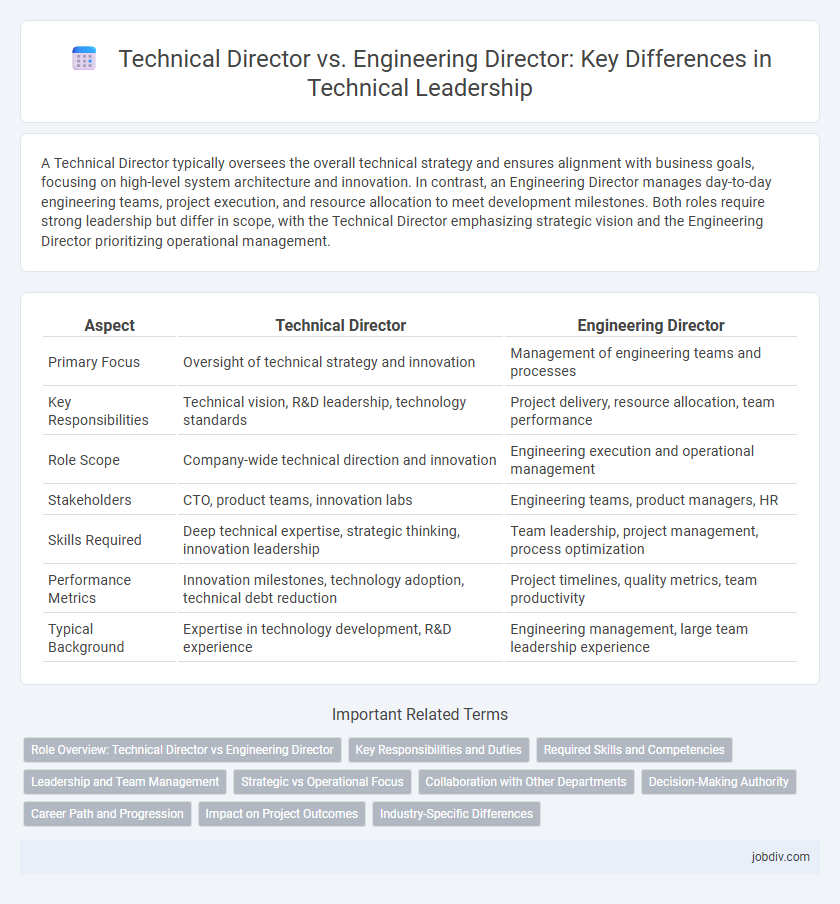A Technical Director typically oversees the overall technical strategy and ensures alignment with business goals, focusing on high-level system architecture and innovation. In contrast, an Engineering Director manages day-to-day engineering teams, project execution, and resource allocation to meet development milestones. Both roles require strong leadership but differ in scope, with the Technical Director emphasizing strategic vision and the Engineering Director prioritizing operational management.
Table of Comparison
| Aspect | Technical Director | Engineering Director |
|---|---|---|
| Primary Focus | Oversight of technical strategy and innovation | Management of engineering teams and processes |
| Key Responsibilities | Technical vision, R&D leadership, technology standards | Project delivery, resource allocation, team performance |
| Role Scope | Company-wide technical direction and innovation | Engineering execution and operational management |
| Stakeholders | CTO, product teams, innovation labs | Engineering teams, product managers, HR |
| Skills Required | Deep technical expertise, strategic thinking, innovation leadership | Team leadership, project management, process optimization |
| Performance Metrics | Innovation milestones, technology adoption, technical debt reduction | Project timelines, quality metrics, team productivity |
| Typical Background | Expertise in technology development, R&D experience | Engineering management, large team leadership experience |
Role Overview: Technical Director vs Engineering Director
The Technical Director oversees the overall technical strategy and innovation, ensuring alignment with business objectives and driving long-term technology vision across projects. The Engineering Director manages engineering teams' execution, focusing on delivering software development, maintaining product quality, and optimizing development processes. Both roles require leadership and collaboration, but the Technical Director emphasizes strategic technology innovation, while the Engineering Director prioritizes team management and operational efficiency.
Key Responsibilities and Duties
A Technical Director primarily oversees the technical strategy, ensuring the implementation of innovative technologies and maintaining quality standards across projects. An Engineering Director focuses on managing engineering teams, optimizing development processes, and delivering products on time and within budget. Both roles require leadership skills but differ in scope, with the Technical Director steering technological vision and the Engineering Director handling operational execution.
Required Skills and Competencies
Technical Directors require strong expertise in system architecture, software development, and technical strategy, emphasizing leadership in innovation and technology integration. Engineering Directors focus on project management, team leadership, and cross-functional collaboration, ensuring efficient engineering processes and delivery. Both roles demand excellent communication, problem-solving skills, and the ability to align technical goals with business objectives.
Leadership and Team Management
Technical Directors emphasize strategic vision and cross-functional leadership, guiding multiple engineering teams towards cohesive project goals. Engineering Directors specialize in operational management, focusing on optimizing engineering processes, resource allocation, and team performance within specific technical domains. Both roles require strong leadership skills, but Technical Directors align broader organizational objectives while Engineering Directors ensure technical execution and team efficiency.
Strategic vs Operational Focus
A Technical Director primarily emphasizes strategic innovation, long-term technology vision, and aligning technical goals with organizational objectives, ensuring the company remains competitive in emerging markets. In contrast, an Engineering Director focuses on operational execution, managing engineering teams, project delivery, and optimizing workflows to meet deadlines and quality standards. Both roles require collaboration but differ fundamentally in scope, one driving technological direction while the other ensures practical implementation and efficiency.
Collaboration with Other Departments
A Technical Director fosters collaboration by aligning technical strategies with business goals, ensuring seamless communication between development, marketing, and product teams. An Engineering Director emphasizes cross-functional teamwork by coordinating engineering workflows with quality assurance, operations, and customer support departments to optimize project delivery. Both roles prioritize interdepartmental synergy to enhance innovation, streamline processes, and achieve organizational objectives.
Decision-Making Authority
Technical Directors typically hold broad decision-making authority over technology strategy and architecture, guiding high-level technical vision and innovation. Engineering Directors focus their decision-making on operational management, resource allocation, and engineering team performance to ensure project delivery aligns with technical goals. Both roles require strategic decisions, but the Technical Director influences long-term technology direction, while the Engineering Director manages short-term execution and engineering processes.
Career Path and Progression
Technical Directors typically advance from senior engineering roles, emphasizing strategic technology leadership and overseeing complex project execution. Engineering Directors generally progress through management tracks, focusing on team leadership, engineering processes, and scaling development operations. Both roles require extensive technical expertise but diverge in scope, with Technical Directors steering innovation and Engineering Directors managing engineering teams and delivery.
Impact on Project Outcomes
Technical Directors drive project outcomes by setting high-level technology strategies and ensuring alignment with business goals, directly influencing product innovation and quality. Engineering Directors manage day-to-day engineering operations, focusing on team productivity, process optimization, and resource allocation, which impacts delivery timelines and code robustness. Both roles collaborate closely to balance strategic vision and operational execution, maximizing project success and technical excellence.
Industry-Specific Differences
Technical Directors typically oversee creative and design aspects in industries like film, gaming, or media, ensuring technical quality and innovation align with artistic goals. Engineering Directors often manage engineering teams in manufacturing, software development, or infrastructure sectors, focusing on project execution, process optimization, and technical resource allocation. Industry-specific demands shape these roles, with Technical Directors emphasizing creative technology integration and Engineering Directors prioritizing engineering efficiency and product delivery.
Technical Director vs Engineering Director Infographic

 jobdiv.com
jobdiv.com